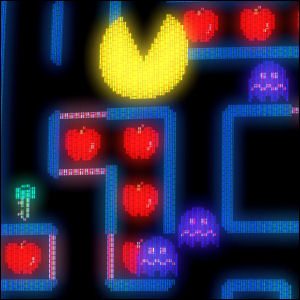 Midway releases the arcade video game Super Pac-Man, licensed from Namco, the Japanese developers behind Pac-Man, of which this game is a direct sequel.
Midway releases the arcade video game Super Pac-Man, licensed from Namco, the Japanese developers behind Pac-Man, of which this game is a direct sequel. ![]()

 Midway releases the arcade video game Super Pac-Man, licensed from Namco, the Japanese developers behind Pac-Man, of which this game is a direct sequel.
Midway releases the arcade video game Super Pac-Man, licensed from Namco, the Japanese developers behind Pac-Man, of which this game is a direct sequel. ![]()
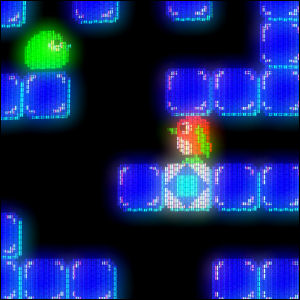 Sega releases the arcade game Pengo in American arcades. The game goes through several iterations and revisions related to the legality of music use.
Sega releases the arcade game Pengo in American arcades. The game goes through several iterations and revisions related to the legality of music use. ![]()
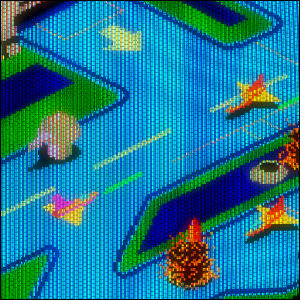 Desperately trying to keep its coin-op games fresh, Sega releases the arcade game conversion kit Super Zaxxon. The kit updates Zaxxon machines with new graphics and levels, giving arcade operators the chance to put a “new” machine in circulation without purchasing an entire new cabinet.
Desperately trying to keep its coin-op games fresh, Sega releases the arcade game conversion kit Super Zaxxon. The kit updates Zaxxon machines with new graphics and levels, giving arcade operators the chance to put a “new” machine in circulation without purchasing an entire new cabinet. ![]()
 Pinball maker D. Gottlieb & Co., via its Mylstar video game division, graces arcades with the qute qreatures of Q*Bert. Though it rakes in quarters abundantly, Q*Bert’s easily recognizable characters briefly prove to be a licensing gold mine, resulting in toys, clothing, children’s books, and even a Saturday morning cartoon. The game is fast-tracked to numerous home video game systems.
Pinball maker D. Gottlieb & Co., via its Mylstar video game division, graces arcades with the qute qreatures of Q*Bert. Though it rakes in quarters abundantly, Q*Bert’s easily recognizable characters briefly prove to be a licensing gold mine, resulting in toys, clothing, children’s books, and even a Saturday morning cartoon. The game is fast-tracked to numerous home video game systems. ![]()
 Konami introduces the arcade game Pooyan in the United States, turning the story of the three little pigs and the big bad wolf into a life-or-death video game struggle.
Konami introduces the arcade game Pooyan in the United States, turning the story of the three little pigs and the big bad wolf into a life-or-death video game struggle. ![]()
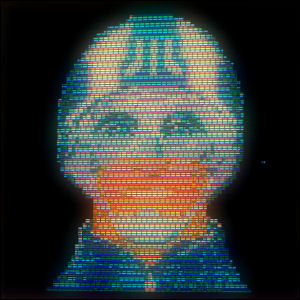 Atari releases the arcade video game Liberator, based on corporate sibling DC Comics’ Atari Force comics.
Atari releases the arcade video game Liberator, based on corporate sibling DC Comics’ Atari Force comics. ![]()
 Konami introduces the arcade game Time Pilot in the United States, where it becomes one of the company’s more prominent sleeper hits. Time Pilot is also licensed to Atari in some regions.
Konami introduces the arcade game Time Pilot in the United States, where it becomes one of the company’s more prominent sleeper hits. Time Pilot is also licensed to Atari in some regions. ![]()
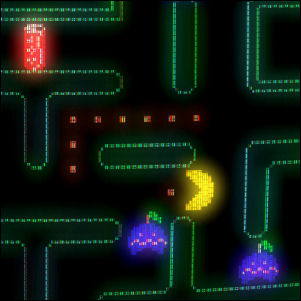 Still trying to stem the tide of bootleg copies of Pac-Man in American arcades, Midway releases the coin-op conversion kit Pac-Man Plus, offering arcade operators an inexpensive (and legal) way to “freshen” old Pac-Man machines on-site rather than turning to bootleg enhancement kits, a problem that has been stealing Midway’s market share since Pac-Man became a hit.
Still trying to stem the tide of bootleg copies of Pac-Man in American arcades, Midway releases the coin-op conversion kit Pac-Man Plus, offering arcade operators an inexpensive (and legal) way to “freshen” old Pac-Man machines on-site rather than turning to bootleg enhancement kits, a problem that has been stealing Midway’s market share since Pac-Man became a hit. ![]()
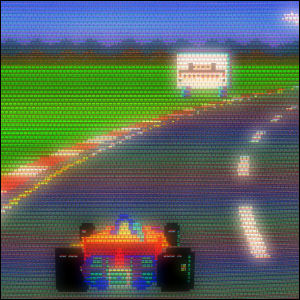 Japanese video game maker Namco releases Pole Position in the United States by way of American licensee Atari. Quickly gaining popularity in arcades, Pole Position marks one of the first “meta” moments in video games, featuring briefly-glimpsed billboards advertising other games by the same manufacturer.
Japanese video game maker Namco releases Pole Position in the United States by way of American licensee Atari. Quickly gaining popularity in arcades, Pole Position marks one of the first “meta” moments in video games, featuring briefly-glimpsed billboards advertising other games by the same manufacturer. ![]()
 Sega releases the arcade game Buck Rogers: Planet Of Zoom in American arcades. Completely unrelated to the recent television series, the graphically impressive game is designed to be the first in a series, but no further games in the projected series ever materialize.
Sega releases the arcade game Buck Rogers: Planet Of Zoom in American arcades. Completely unrelated to the recent television series, the graphically impressive game is designed to be the first in a series, but no further games in the projected series ever materialize. ![]()
![]()
 Atari releases the arcade video game Xevious, licensed from Namco, the Japanese developers behind Pac-Man.
Atari releases the arcade video game Xevious, licensed from Namco, the Japanese developers behind Pac-Man. ![]()
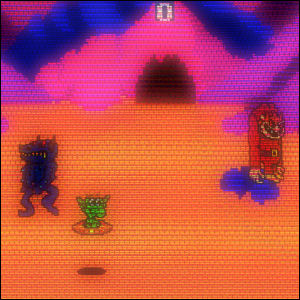 Midway releases the arcade video game Wacko, a game designed to defy having its cabinet converted into another game with a unique asymmetrical design.
Midway releases the arcade video game Wacko, a game designed to defy having its cabinet converted into another game with a unique asymmetrical design. ![]()
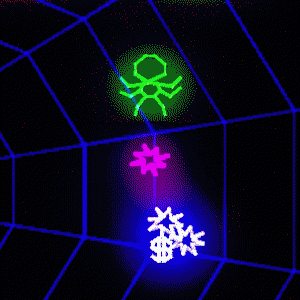 Atari releases the arcade video game Black Widow, a twin-joystick vector graphics game.
Atari releases the arcade video game Black Widow, a twin-joystick vector graphics game. ![]()
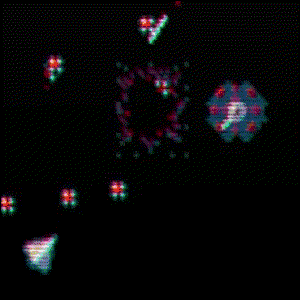 Williams Electronics releases the arcade video game Sinistar, designed by Noah Falstein and John Newcomer, and coded by a team including R.J. Mical, Sam Dicker, Ken Graham, and Richard Witt. With digitized pre-recorded speech from a professional voice actor lending the titular Sinistar a booming, terrifying voice, the game (and its difficulty) soon become legendary.
Williams Electronics releases the arcade video game Sinistar, designed by Noah Falstein and John Newcomer, and coded by a team including R.J. Mical, Sam Dicker, Ken Graham, and Richard Witt. With digitized pre-recorded speech from a professional voice actor lending the titular Sinistar a booming, terrifying voice, the game (and its difficulty) soon become legendary. ![]()
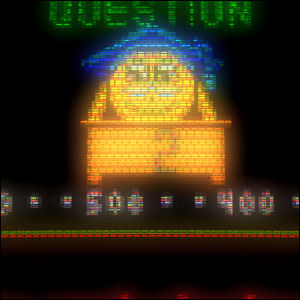 Midway releases the arcade video trivia game Professor Pac-Man, a quiz game tenuously connected to the company’s string of Pac-Man sequels. Few cabinets are produced due to very low early sales, so Professor Pac-Man is a rare find.
Midway releases the arcade video trivia game Professor Pac-Man, a quiz game tenuously connected to the company’s string of Pac-Man sequels. Few cabinets are produced due to very low early sales, so Professor Pac-Man is a rare find. ![]()
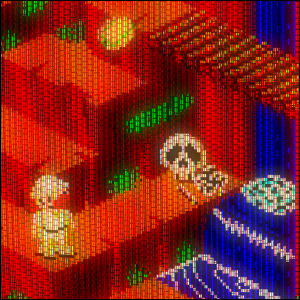 Sega releases the arcade game Congo Bongo in American arcades. Using the same graphical approach as Zaxxon, Congo Bongo is a 3-D take on the oddly familiar theme of a man climbing a structure to capture an ape.
Sega releases the arcade game Congo Bongo in American arcades. Using the same graphical approach as Zaxxon, Congo Bongo is a 3-D take on the oddly familiar theme of a man climbing a structure to capture an ape. ![]()
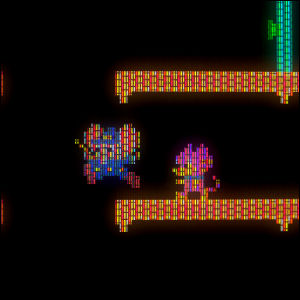 Midway releases the arcade video game Mappy, licensed from Namco, the Japanese developers behind Pac-Man.
Midway releases the arcade video game Mappy, licensed from Namco, the Japanese developers behind Pac-Man. ![]()
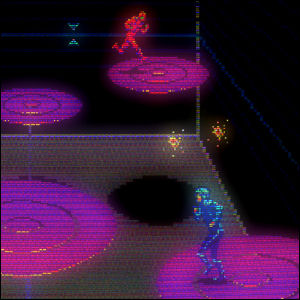 Midway releases the arcade game Discs Of Tron in American arcades. The second coin-op game based on the movie Tron, this game was originally devised as an additional “stage” of the original Tron coin-op until designers split it off into its own game. The “environmental” cabinet, allowing players to stand inside the brightly black-lit game, becomes a legend of arcade architecture.
Midway releases the arcade game Discs Of Tron in American arcades. The second coin-op game based on the movie Tron, this game was originally devised as an additional “stage” of the original Tron coin-op until designers split it off into its own game. The “environmental” cabinet, allowing players to stand inside the brightly black-lit game, becomes a legend of arcade architecture. ![]()
![]()
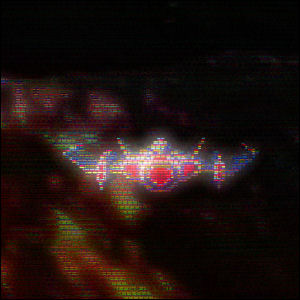 Segaa releases the arcade game Astron Belt in American arcades. The first game to go into development specifically as a laser videodisc game, Astron Belt is a minor hit but it overshadowed by the Disney-esque visuals of another laserdisc coin-op, Dragon’s Lair.
Segaa releases the arcade game Astron Belt in American arcades. The first game to go into development specifically as a laser videodisc game, Astron Belt is a minor hit but it overshadowed by the Disney-esque visuals of another laserdisc coin-op, Dragon’s Lair. ![]()
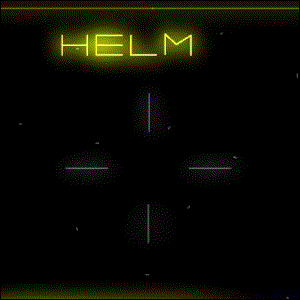 Segaa releases the arcade game Star Trek: Strategic Operations Simulator in American arcades. The vector graphics coin-op, simulating the “tactical views” seen on the Enterprise in the first two Star Trek movies, is the first officially licensed Star Trek video game. It also reflects some corporate synergy: Sega was, at the time, also owned by Paramount Pictures parent company Gulf + Western.
Segaa releases the arcade game Star Trek: Strategic Operations Simulator in American arcades. The vector graphics coin-op, simulating the “tactical views” seen on the Enterprise in the first two Star Trek movies, is the first officially licensed Star Trek video game. It also reflects some corporate synergy: Sega was, at the time, also owned by Paramount Pictures parent company Gulf + Western. ![]()
![]()
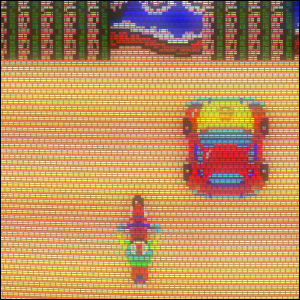 Williams Electronics releases the arcade video game Motorace USA, a scrolling racing game developed by Japanese game manufacturer IREM (who were also behind the Williams-licensed hit Moon Patrol). In other regions the same game is known as Traverse USA and Zippy Race.
Williams Electronics releases the arcade video game Motorace USA, a scrolling racing game developed by Japanese game manufacturer IREM (who were also behind the Williams-licensed hit Moon Patrol). In other regions the same game is known as Traverse USA and Zippy Race. ![]()
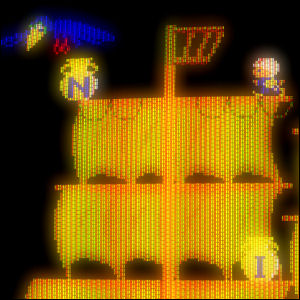 Atari releases the arcade video game Arabian, developed by Sun Electronics.
Atari releases the arcade video game Arabian, developed by Sun Electronics. ![]()
 Mere weeks before Return Of The Jedi arrives in theaters, Atari releases the arcade game Star Wars in the United States, in both upright (standing) and cocktail (sit-down) models, complete with almost-intelligible sample voices from the movie of the same name. Players strafe the Death Star at lightning speeds (thanks to vector graphics, which can draw faster than full-screen raster graphics) after fending off TIE fighters. The Force is with us… for 25 cents.
Mere weeks before Return Of The Jedi arrives in theaters, Atari releases the arcade game Star Wars in the United States, in both upright (standing) and cocktail (sit-down) models, complete with almost-intelligible sample voices from the movie of the same name. Players strafe the Death Star at lightning speeds (thanks to vector graphics, which can draw faster than full-screen raster graphics) after fending off TIE fighters. The Force is with us… for 25 cents. ![]()
![]()
 Konami introduces the arcade game Gyruss in the United States, a space shooter with a vaguely 3-D perspective and a thumping Bach-by-way-of-techno soundtrack.
Konami introduces the arcade game Gyruss in the United States, a space shooter with a vaguely 3-D perspective and a thumping Bach-by-way-of-techno soundtrack. ![]()
 Gottlieb introduces the arcade game Krull in the United States, based on the much-hyped fantasy movie of the same name.
Gottlieb introduces the arcade game Krull in the United States, based on the much-hyped fantasy movie of the same name. ![]()
![]()
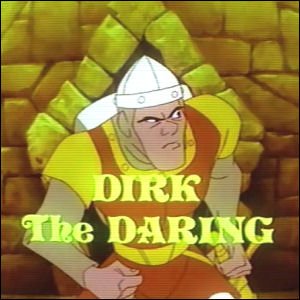 The ongoing race to improve arcade game graphics takes a sudden turn with the introduction of the first laserdisc-driven game to hit arcades, Dragon’s Lair. Featuring animation by former Disney protege Don Bluth, and a branching structure that depends heavily on players performing the right actions at just the right times, Dragon’s Lair is rigid in game play, but breathtaking in beauty; most arcade operators set the price for a single game at 50 cents just to offset the cost of the machine – and players gladly wait in line just to watch others guide Dirk the Daring through the castle.
The ongoing race to improve arcade game graphics takes a sudden turn with the introduction of the first laserdisc-driven game to hit arcades, Dragon’s Lair. Featuring animation by former Disney protege Don Bluth, and a branching structure that depends heavily on players performing the right actions at just the right times, Dragon’s Lair is rigid in game play, but breathtaking in beauty; most arcade operators set the price for a single game at 50 cents just to offset the cost of the machine – and players gladly wait in line just to watch others guide Dirk the Daring through the castle. ![]()
 Atari releases the arcade video game Crystal Castles, an internally developed game featuring a new character, Bentley the Bear.
Atari releases the arcade video game Crystal Castles, an internally developed game featuring a new character, Bentley the Bear. ![]()
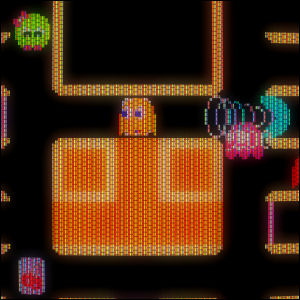 Midway releases the arcade video game Pac ‘N’ Pal, licensed from Namco, the Japanese developers behind Pac-Man, of which this game is a loose sequel.
Midway releases the arcade video game Pac ‘N’ Pal, licensed from Namco, the Japanese developers behind Pac-Man, of which this game is a loose sequel. ![]()
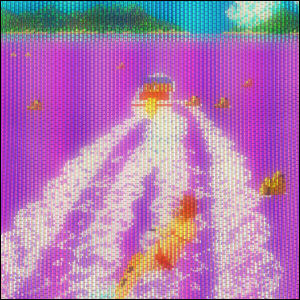 IREM releases the arcade video game Tropical Angel, a water skiing game.
IREM releases the arcade video game Tropical Angel, a water skiing game. ![]()